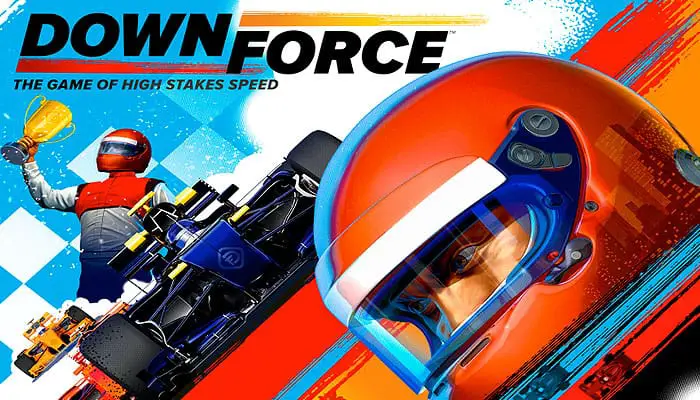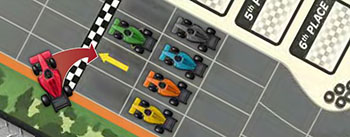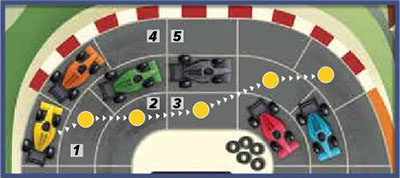
High-stakes bidding on million-dollar race cars. Frantic bets placed in secret as the cars race around the track . And to the victor, the biggest payout of all.
In the world of motor racing, the margin between victory and defeat can be a single moment: a steep banked turn, tires screaming and spitting out smoke, and the downforce, pressing you down in your seat and keeping you on the track as you make your move inside to pull ahead.

Components
- 1 Double-Sided Game Board
- 6 Race Car Pawns
- 42 Regular Speed Cards
- 6 Speed-8 Speed Cards
- 6 Power Cards
- 6 Driver Plaques
- 1 Pad of Score Sheets
Setup

Place the game board in the center of the table on either side. (Each side has a unique track).

Give each player a score sheet and something to write with (not included).

Shuffle the six Speed-8 speed cards and the six power cards separately and make two face down piles.

Shuffle the 42 regular speed cards and deal them out, face down, equally to each player.
(In 4- and 5-player games, there will be 2 cards left over - return those to the box).

Place the driver plaques by the side of the board.

Randomly put all six cars onto the starting spaces on the board.

Game Play
A game of Downforce has three parts:
- The Auction: The cars are auctioned off to the highest bidder.
- The Race: The cars race around the track.
- The Betting: which takes place during the race, when players bet on who the winning car is going to be.
After the race is over, players add up all their money to see who wins.
The Auction
After players look at their hands of cards, the cars are auctioned off one at a time.
Flip over the top Speed-8 card and the top power card from the decks. The car color shown and the power listed are up for bid.
To bid, each player chooses a card from their hand and places it face down on the table. After everyone has chosen a card, flip over the cards. The number on the card matching the color of the car up for bid is how much you bid for that car (in $M).
The player whose speed card has the highest value of the car color shown wins the bid and pays that much, noting the amount on their score sheet.
If two or more cards have the same value, the card with more cars on it wins.
If both tied cards have the same number of cars, the one without the wild symbol wins.
When a player wins a bid, they:
- write the amount of their bid on their score sheet
- add the matching Speed-8 card to their hand
- put the power card face up in front of them
- take the matching driver plaque and place it in front of them
All bid cards are returned to players' hands and can be used again to bid for another car in the auction.
A new car and power card are revealed and bidding continues, each time with a new car and power card.
Every player must have at least one car. When the number of cars remaining equals the number of players without cars, only players without cars can bid. When only one car is left, if there is a player without a car, they reveal the card in their hand with the lowest value of that color and bid that much.
After all cars are auctioned off, any player who has more than one power card selects one and returns the others to the box. The power card they keep applies to all of their cars.
Auction Example: The green car and the Cunning power card are revealed for auction.

All four players choose and reveal a card from their hand.

Players 2 and 4 are tied at 6, but Player 2's card has more cars on it, so he gets the car and power card.

He marks his score sheet with a 6, places the Speed-8 card in his hand, and takes the green driver plaque and the Cunning power card.

All players return their cards to their hand.
The Race
The player who controls the car on the  space takes the first turn. During the race, each player will play one speed card from their hand and resolve it. Then the player to their left takes the next turn. Play continues until all the cars have finished the race or no more cards can be played.
space takes the first turn. During the race, each player will play one speed card from their hand and resolve it. Then the player to their left takes the next turn. Play continues until all the cars have finished the race or no more cards can be played.
Playing Speed Cards
Each car whose color appears on the card is moved the number of spaces indicated on the card. Cars are always moved in order from top to bottom (unless the player has the Tricky power). The player who played the card moves all of the cars on the card, even if the cars belong to other players (unless the car is controlled by someone with the Cunning power).
After the card is resolved, place it face up in the discard pile.

Wilds
White cars are wild. The player who played the card may pick any color car to move, other than a color that is already on the card (unless that player has the Unpredictable power). They may pick a color of a car that has already finished the race or one that can't move because it is blocked by other cars.
If a player plays a card with two wild cars on it, they must choose two different color cars.

Moving Cars On The Track
Cars move forward on the track to the next adjacent space, either straight or diagonally. A car may not move sideways or backwards. Cars may not move through other cars, though they may move diagonally between two cars that are adjacent diagonally. A space is considered "forward" if the front end of the new space is further ahead than the front end of the space they moved out of.
Each car must be moved the full number of spaces if possible, or as far as possible if they cannot move the full amount. If there is a legal move for a car, the player must move it. But they may move a car strategically so it is blocked by other cars and can't move the full amount.

Blue moves 4 spaces. It can move into space 1 because it is diagonally forward. It cannot move into space 2 because that space is sideways. It can move into space 3, but it would not be able to move farther because it would be blocked.

Yellow moves 5 spaces. It's only option for its first move is to move to space 1, which works because the front end lies ahead of the front end of the space where it started.
Likewise, the rest of the path shows the only possible movement options for yellow. Green may not move into space 2 or space 4 since the front end of those spaces are not farther ahead than the space started on. Green's first move must either be to space 3 or space 5.

Orange moves 6 spaces. Because blue is blocking the path, orange can only move 3 spaces and loses the rest of its movement.

Players can choose to move a car so that it deliberately gets "jammed up" and can't complete the full move.
The Betting
There are three lines on each race track indicating when betting occurs. Once a car first crosses the first betting line and after all of the movement on the card has been resolved, each player secretly marks on their score sheet which of the six cars they think will finish the race in first place.
Players may bet on their own cars or on other players' cars. Bets are made in the same way after the first time a car crosses the second and third betting lines. Players may bet on the same car more than once or on all different cars.
At the end of the race, players gain money for each of their bets as indicated on the score sheet if the cars they bet on finished first, second, or third.

Power Cards
Each player has a power card that can affect movement or one of the other rules. When a power contradicts a rule, the power takes precedent over the rule.

 Aggressive
Aggressive
Example: If you control the red car and play this card, you can move the red car 7spaces instead of 6.
Note: This power does not work if a wild is first on the card, even if you use it for your car.
 Cunning
Cunning
You get to decide where your cars move, even on other people's turns, but it is up to you to remember to move your cars during other people's turns!
 Determined
Determined
To use this power, the car must enter only rectangular spaces during regular movement. The starting space, and the bonus movement spaces, may be straight or curved. Move the additional spaces immediately after your car is moved, even if there are other cars on the card after yours.

 Strategic
Strategic
Example: If you play this card, you could choose to ignore any one of the cars. Just skip that car and move on to the next car.

 Tricky
Tricky
Example: If you play this card, you could move the cars as follows: orange 1, then yellow2, then red 4, then black 6. Or you could move them the regular order - you decide.

 Unpredictable
Unpredictable
Example: If you play this card, you can choose to use the wild to move the blue, orange or yellow car 2 spaces (in addition to the regular choices of red, black, and green).
Finishing The Race
As soon as a car crosses the finish line, it is placed in the appropriate winner's space near the race track. It does not matter how far past the finish line a car goes.
When all of a player's cars have finished the race, they discard the rest of their hand without effect and play no more cards in the race. It is possible that some cars will not cross the finish line. These cars stall out, do not finish the race, and do not collect any money.
End of the Game
After all cars have finished the race, players mark on their score sheets how much money they earn for each of their cars based on how they finished.
They then circle any money they won through betting. This money is added up, and the initial bid money is subtracted from it.
The money remaining is their winnings. The player with the most winnings wins the game.
In the case of a tie, the player whose car finished higher wins the tie.

Continue Reading

